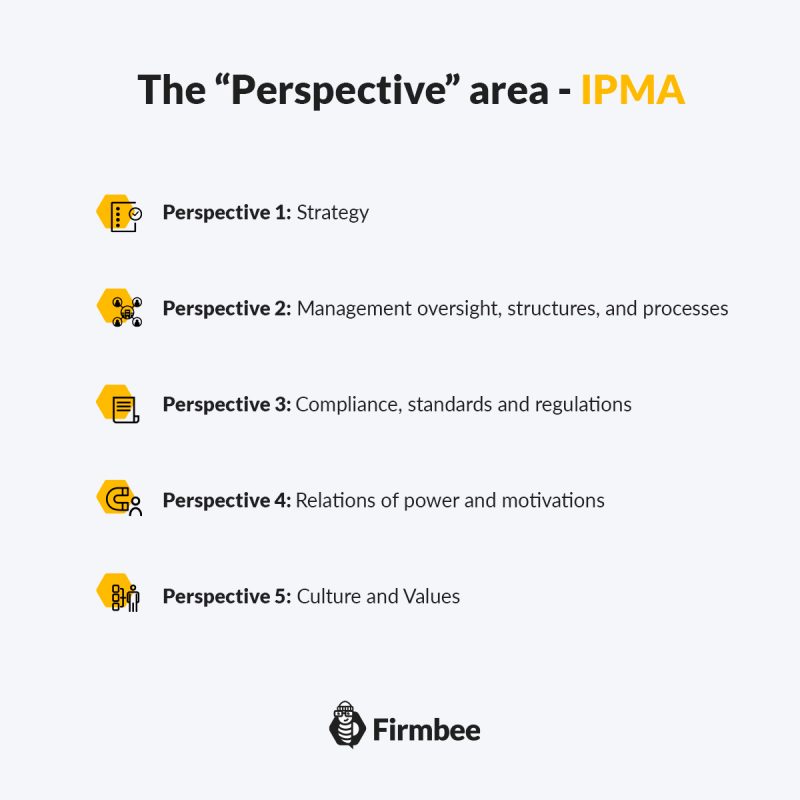In the previous section, we wrote about the IPMA Individual Competence Guidelines, which cover three areas: Perspective, People, and Practice, forming the so-called IPMA Competency Eye. Today we will outline the competencies in the Perspective area: the tools and techniques by which individuals interact with their environment, and the rationale that drives people, organizations, as well as associations to initiate and support projects, programs, or portfolios.
Perspective area – table of contents:
- Perspective area – introduction
- Perspective 1: Strategy
- Perspective 2: Management oversight, structures, and processes
- Perspective 3: Compliance, standards and regulations
- Perspective 4: Relations of power and motivations
- Perspective 5: Culture and Values
Perspective area – introduction
The external factors and conditions spark support and determine every project and program. People, organizations, and communities have various, often even contrary expectations. The level of complexity they have become is hard to grasp. Fortunately, launching a program or project may provide some insight in such cases.
Perspective 1: Strategy
We can divide the determinant of any project or program into formal disclosed goals or needs of an organization and less formal, implicit motives and interests. A great example of the formal, plain most tangible ones is an organization’s strategy. Usually, it has clear goals and objectives with projects and programs contributing to achieving them. Since it’s according to these goals, portfolios, programs, and projects you prioritize.
Perspective 2: Management oversight, structures, and processes
The organizational and external elements of competencies – i.e., oversight, structures, and process – form the formal environment for a project, program, or portfolio. The number and level of dependencies and interrelationships they establish with their environment define their complexity. This indicates, that they focus on handling certain processes or structures that used to serve a clear purpose at the time of creation but have become outdated and of little use in the current situation.
Perspective 3: Compliance, standards and regulations
Compliance, standards and regulations also contain important context and determinants. They consist of issue-related laws, standards, regulations as well as tools that reflect the organization’s priorities, best practices and requirements.

Perspective 4: Relations of power and motivations
The balance of power and incentives between people in the organization provides yet another outlook to consider, as they may become the key elements that determine the success of a particular project, program or portfolio. At the same time, these power relations make up the informal equivalent of organization’s strategy. Formal rules and goals alone can’t determine choices people. We mustn’t forget about their personal ambitions too.
Perspective 5: Culture and Values
The fifth perspective i.e, the organization’s culture and values, are predominantly informal and implicit. Though a company may plainly attempt to influence the informal culture with formal goals or missions, the core cultural values will remain implicit and informal. What’s more, these values influence the other contextual elements – that is, commonly available strategies, rules and regulations, etc. That’s why, knowledge of the customs, mores, conventions and practices of an organization is crucial for any given project, program or portfolio to succeed.
Today we discussed the Individual Competence Baseline in the Perspective area. Follow our category: IPMA Certification Guide, so you don’t miss the next articles in this series.
If you like our content, join our busy bees community on Facebook, Twitter, LinkedIn, Instagram, YouTube, Pinterest.
Author: Caroline Becker
As a Project Manager, Caroline is an expert in finding new methods to design the best workflows and optimize processes. Her organizational skills and ability to work under time pressure make her the best person to turn complicated projects into reality.


















